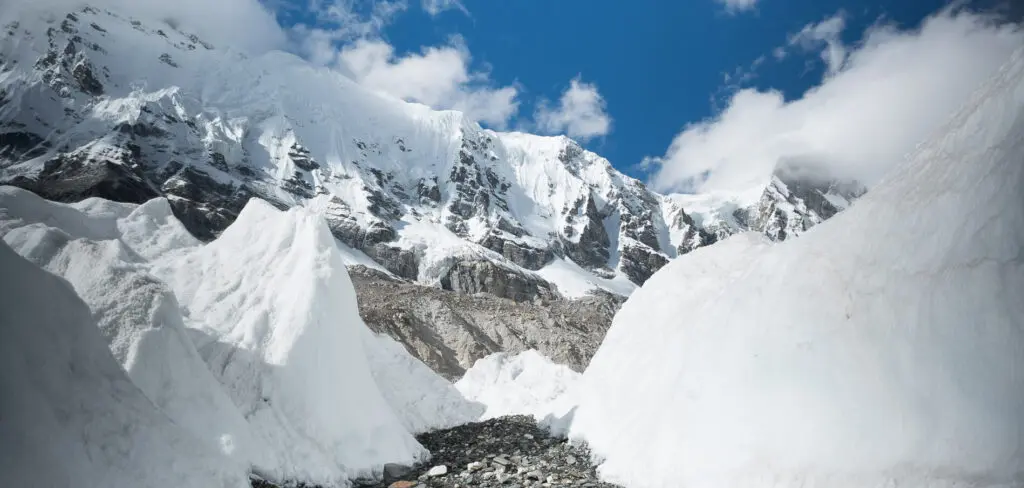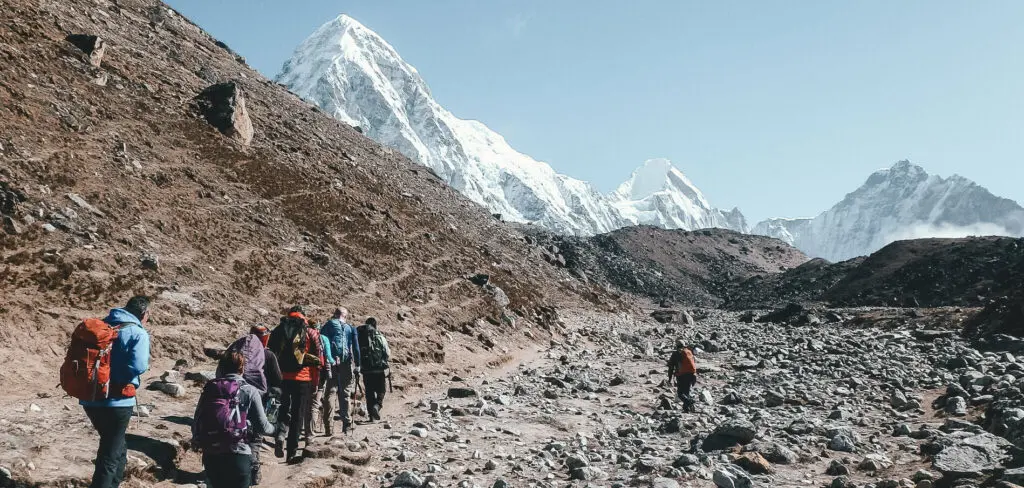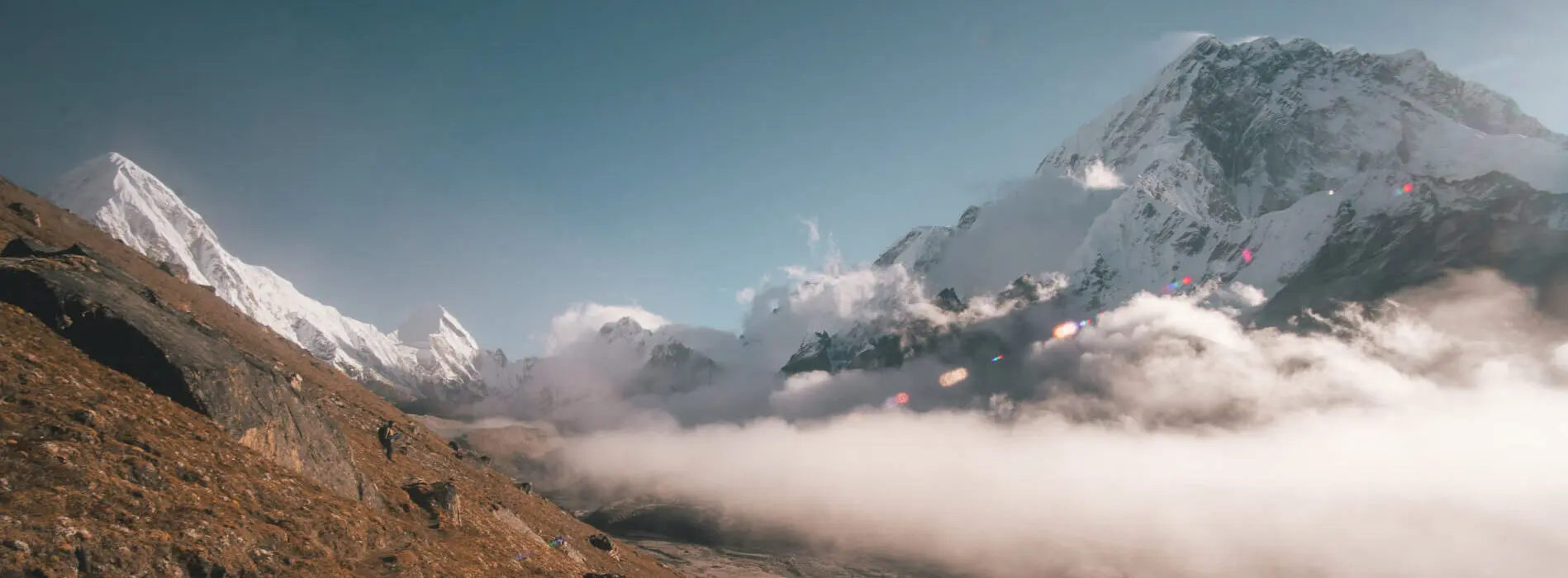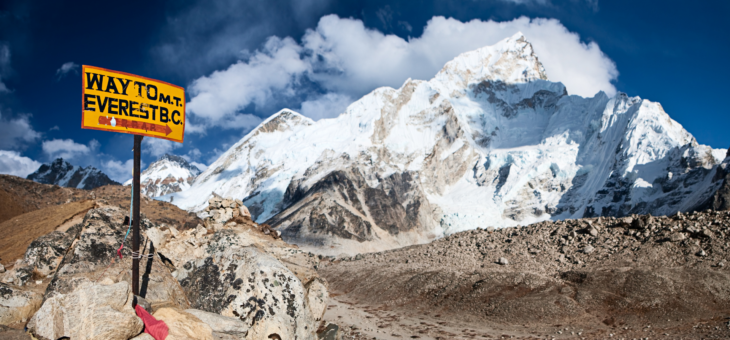Climbing to the foothills of Mount Everest is one of the most magical treks in the world. You’ll trek through the Khumbu Valley, meet the local sherpa people along the way and be surrounded by the most incredible mountain views you could ask for. If you’re thinking about going to trek Everest Base Camp in 2022, now is the time to plan, plot and get excited! This bumper post has all the information you need, so read on for all you need to know…

- How hard is it to trek Everest Base Camp?
- How long does it take?
- What is the food like?
- How much does it cost?
- What’s the accommodation like?
- Is it safe to trek Everest Base Camp?
- What do I need to pack?
- How do I train for Everest Base Camp?
- When can I trek Everest Base Camp in 2022?
How hard is it to trek Everest Base Camp?
We give every one of our expeditions a level. The trek to Everest Base Camp is a level 4. That means you can expect to trek…
An average of 5 to 7 hours per day at altitudes not usually exceeding 5,500 metres. Some days may be up to 12 hours long but that is not typical. Typical elevation gain per day would be 400 – 800 metres, with some days as much as 1000 metres. As a rough guide, you should be comfortable hillwalking for 6 to 7 hours per day for two days in a row.
What is the route like?
Our route takes you on the beautiful and historic trek through the Khumbu Valley to Everest Base Camp sitting at the foot of Mt Everest. We want to really take the time to appreciate all of the incredible sights that we pass along the way, so we take it at a leisurely pace. Slow and steady wins the race!
While the expedition in total is 18 days long, our trek to Everest Base Camp takes 8 days, allowing for 2 rest and acclimatisation days. In total, including the descent, we spend 13 days trekking (including those rest days). This pace is a really important part of our expedition. It means that we acclimatise gradually, which greatly increases the chances of reaching our goal comfortably and safely.
How fit do I need to be to trek to Everest Base Camp?
All of our expeditions require a good level of fitness, which is very achievable if you train in the months leading up to the trek. We’ll advise you as to the best way to do this, and you can read up a little more about training advice for Kilimanjaro, a level 5 trek, here.
Make no mistake – for many people, this will be the toughest trek of their lives. Although this is not a technical climb, it is very steep in places and you will be gaining height very quickly. So it’s vital to train properly beforehand, to increase your chances of getting there successfully.
Don’t forget, we are the only company in the world who send an international guide and doctor on all Everest Base Camp (5,364m) expeditions while keeping group sizes sustainably small.
How long does it take to trek everest base camp in 2022?
Like we said, our expedition is 18 days long, in total. We move through the incredible Khumbu Valley at a slow, manageable pace. Why is this pace so important? Well, it means we…
- Acclimatise properly to the altitude
- Allow for all-important rest days
- Take the time to meet the locals and absorb the sights
- Keep to a pace that we can maintain
How long is the trek to base camp itself?
We spend 8 days in total trekking to Everest Base Camp. That allows for 2 rest and acclimatisation days along the way. Remember, Everest Base Camp is at an altitude of 5,364m.
What about the descent?
Once we’ve reached base camp, you might think that the best is behind you. But you’d be wrong! Our descent is incredibly scenic, too. You’ll take in some incredible Himalayan views on our way to Lukla, where we fly back to Kathmandu.
Is there any spare time?
On our expedition to Everest Base Camp, we spend time in Kathmandu. This wonderfully bustling city is a great contrast to the peace of the mountains. By seeing both, you’ll get a great insight into Nepal. Which, if you’re flying all that way, is definitely what you want!
How much does it cost to trek everest base camp 2022?
The Earth’s Edge expedition to Everest Base Camp currently costs €3,999*. That price includes…
- International flights from Dublin to Kathmandu return (Economy Class) (UK flights not included)
- Internal flights in Nepal
- Experienced Irish/UK expedition leader
- Experienced Irish/UK expedition doctor
- Training Weekend
- Local English speaking guides, cooks and support team
- All accommodation based on twin sharing in hotels in Kathmandu and in guest houses elsewhere
- All meals and drinking water except in Kathmandu where accommodation is based on B&B
- A celebratory dinner
- All transport throughout the expedition
- All group gear consisting of first aid kits, mountaineering equipment, cooking equipment etc
In short? Pretty much everything!
We can only speak for ourselves, of course. Prices may vary between other companies, but it’s really important to know all of your costs up front. A bargain price isn’t a bargain if you end up shelling out more cash on the ground. And don’t forget – your safety is the most important thing. Safety, more than cost, should be your primary concern when trekking to Everest Base Camp. Remember, all of our trips are accompanied by a doctor from the UK or Ireland.
Trekking to Everest Base Camp from the UK
If you are joining the expedition to Everest Base Camp from the UK, you can book our trip without flights, for €3,299*. Then you can organise your own flights from the UK. You’ll also have to book your internal flights, but we’ll tell you which ones to book. We can also organise your airport transfers, if you like.
How do I cope with altitude sickness?
While nothing compared to Mount Everest itself, the trek to Everest Base Camp goes through some pretty serious elevations. Base Camp itself is 5,364m (so a smidge lower than the peak of Kilimanjaro, at 5,896m). We send an international doctor along on every single on of our expeditions. Our doctors (as well as our guides and porters) are trained to help you cope at altitude. We also take a slow pace, with rest days, to help us all acclimatise to the altitude. The most important thing to remember? Drink plenty of water, go slowly, eat plenty and be sure to tell our expedition doctor the second you feel unwell.
Read more about coping with altitude in our blog post.

What’s the accommodation like on Everest Base Camp?
Unlike a lot of other expeditions, on the trek to Everest Base Camp we stay mostly in tea houses along the way, rather than camping. This means a proper bed and, if you’re lucky, a hot shower! Now, tea houses are far from luxurious, but they have everything you need. Just remember you’ll need to pay a bit extra if you want to use the electricity or WiFi.
Like we said, the tea houses are a real step up from camping. That said, accommodation on the Everest Base Camp trek isn’t luxurious, so don’t be expecting hotel style digs. But these lodges are perfectly comfortable and a little slice of heaven after a long day on your feet.
The Beds
In the rooms, you’ll find two single beds. Most have bedding on but you’ll also have your sleeping bag, which is more important as you climb higher and higher. When the temperatures drop, you’ll be glad of your sub-zero sleeping bag!
The Bathrooms
Though basic, the bathrooms have everything you need, including a hot shower. But they’re not always available! If they are, try to make your shower the first thing you do when you get to the tea house, as the hot water can run out as the night goes on. In some places, the toilet will be a long drop squat affair. So try and strengthen those legs before you set off!
The People
As well as our own group, you’ll meet plenty of other trekkers who are making their way along the path. This makes for great conversation in the evening, as we sit around the fire and make friends.
The Power
As we said in this post about taking electronics to Everest Base Camp, tea houses have electrical charging points where you can charge your phones for a fee. Depending on how busy it is, there may be a queue. It’s a good idea to bring a power bank, too. Don’t forget to bring an adaptor – in Nepal you need a type C plug.
Is it safe to trek Everest Base Camp?
While Everest is a dangerous mountain to climb, the trek to Everest Base Camp is generally very safe, if you go with a good team. When you hear about tragedies on Everest, they generally take place much, much further up the mountain.
That said, there is a level of risk on any mountain. Everest Base Camp is at higher altitude, so the regular risk of altitude sickness is there. But at Earth’s Edge, we send an international doctor on every single one of our expeditions. That means if you start to feel unwell (and tell the doctor immediately) then care is right at your fingertips.
How to find good porters
At Earth’s Edge, we pride ourselves on the relationships we’ve built with incredible teams around the world. Our local Nepalese porters and guides know every inch of this trek (and will amaze you with their speed and dexterity!) They know the area, and they know exactly what they’re doing. That’s hugely important when it comes to a safe trek.
As well as our doctor, we also send an international guide on every expedition. They’ll be there to help you at every step of the way.
What if I do get sick?
If you do start to feel the effects of the altitude, don’t panic. It can happen to anyone, no matter how fit or healthy you are. All you need to do is tell the doctor as soon as you start to feel unwell. Often, you just need to drink a load of water and take a painkiller. You might need to slow down a little, too. But again, don’t worry. The sooner you catch it, the sooner you get better.
What if I fall behind?
Like all of our expeditions, the trek to Everest Base Camp isn’t a race. There are no prizes for reaching camp first! In fact, the slower you take the hike, the better. Hiking slowly is one of the best ways to acclimatise to the altitude. Remember, we have a team of guides and porters who will walk at the pace you need to walk at. You will never be left behind.
What if I can’t make it to base camp?
The reality of trekking is that sometimes we don’t make it to our final destination. Sometimes in life, we simply can’t make the summit, whether it’s due to bad weather on Elbrus or a dicky tummy in Kilimanjaro. That’s life! If you don’t feel well or fit enough to make it to base camp, one of our porters will walk back with you.

What do I need to pack?
If you tend to start planning your suitcase months before a trip, then you’ll want to take a good look at our expedition kit list now! When you book with Earth’s Edge, we send you a comprehensive packing list, so you won’t get to Kathmandu and realise you’ve forgotten your socks. As well as all of the clothing, you’ll also need hiking poles, water bottle and bladder, sleeping bag, rucksack and good, worn in hiking boots.
Sleeping Bag
This is an important one! Your sleeping bag for Everest Base Camp needs to be nice and warm. We recommend a comfort rating of -15°C or lower. The nights can get chilly and there’s nothing worse than trying to sleep when you’re cold. This one from Snugpak is a perfect option.
Hiking Boots
A decent pair of walking boots will be your best friend on this trek. Buy the best that you can afford, get them in a shop so you can be fitted properly, and break them in before you leave. If they still feel like new when you’re starting to hike, you’ll be asking for trouble. Read our guide to finding the perfect pair here.
Rucksack
As well as your main duffel bag (which is carried by the support team) you’ll need to bring your own rucksack as a day bag, to carry all the equipment you’ll need. This will fit your camera, spare jacket, waterproof, water bottle and packed lunch, so about 30 to 35 litres in size will do. Make sure you get fitted for it and break this in before you head off. You mightn’t think it, but a backpack needs to be worn in just as much as hiking boots.
Hiking Poles
This is a vital bit of Everest Base Camp equipment. Get a lightweight pair that are adjustable but lock – you can read the tips from our guide here about his favourite kind.
Water Bottle and Water Bladder
It’s so important to keep hydrated. You must have the capacity to carry 3 litres of water with you, so bring a bottle with a wide neck, like this one. A Platypus is also great for hands-free hydration during the day, but note that the water can freeze in the tube, so you’ll want a bottle for the evenings, too.
Obviously, this isn’t all you need. After all, you can’t trek in the nip! But once you’re booked onto our Everest Base Camp expedition, we’ll send you a comprehensive packing list for all the clothes and necessities you’ll need to bring. You can read more about the expedition here.
How do I train for Everest Base Camp?
When it comes to training for Everest Base Camp, every person is different. There is no one training plan that will work for everyone. You do need to make sure you have a good level of physical fitness.
At Earth’s Edge, we give all of our expeditions a level, so you know what to expect. Our trek to Everest Base Camp is a level 4 expedition. That means you can expect to trek for an average of 5 to 7 hours per day at altitudes not exceeding 5,364 metres.
How fit do I need to be?
We spend 8 days trekking to Everest Base Camp, which gives us time to acclimatise to the altitude. We also have two rest days, which help that process even more. But in order to enjoy the expedition as best you can, it’s important to have a good level of physical fitness. As a rough guide, you should be comfortable hillwalking for 6 to 7 hours per day for two days in a row.
How should I train for Everest Base Camp?
While you need to include hillwalking in your training, it’s a good idea to mix in cardiovascular training, too.
When can I trek Everest Base Camp in 2022?
We have a number of different expeditions available to trek Everest Base Camp in 2022. Here are the dates…
30 March 2022 – 16 April 2022
8 April 2022 – 25 April 2022
19 April 2022 – 6 May 2022
26 April 2022 – 13 May 2022
21 September 2022 – 8 October 2022
27 September 2022 – 14 October 2022
7 October 2022 – 24 October 2022
12 October 2022 – 29 October 2022
Some of these dates are fully booked, but there are still spaces available on some dates. If you want to read more about our expedition to Everest Base Camp, click here!
*Prices in this blog are accurate at the time of writing in December 2021. These prices are subject to change






